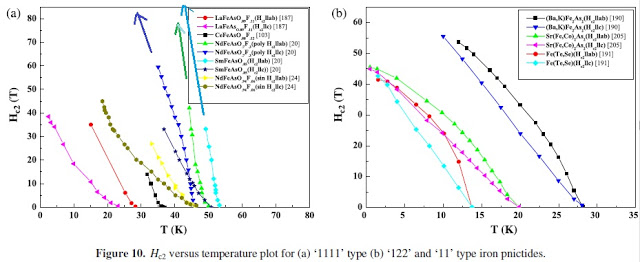Ad Support : Nano Technology Netbook Technology News Computer Software
1. There are indications that iron based superconductors could achieve critical fields as high as 204 Tesla to as high as 900 Tesla. An Overview on Iron Based Superconductors is a 20 page pdf. The 204 Tesla is based on the WHH method of extrapolation and the 900 tesla is based on using a graphical extrapolation of the above known data points.
A recent very high critical field of 122 Tesla (by WHH extrapoliation) for the La based system.
From figure 10 – NdFeAsO.7F.3 and Sm compound and another Nd compound seem to track to very high Hc2(Tesla)
H/T Talk Polywell
2. Nature Physics – How grain boundaries limit supercurrents in high-temperature superconductors
The model does not suggest a way to break down the barriers, although Hirschfeld said it will give researchers a better tool to interpret results of past and future experiments. This gives the team hope that their model could provide a focus for future efforts to overcome the problem.
The interface properties of high-temperature (high-Tc) copper oxide superconductors have been of interest for many years, and play an essential role in Josephson junctions, superconducting cables and microwave electronics. In particular, the maximum critical current achievable in high-Tc wires and tapes is well known to be limited by the presence of grain boundaries, regions of mismatch between crystallites with misoriented crystalline axes. Studies of single artificially fabricated grain boundaries have revealed that the critical current Jc of a grain boundary junction depends exponentially on the misorientation angle. Until now microscopic understanding of this apparently universal behaviour has been lacking. We present here the results of a microscopic evaluation based on a construction of fully three-dimensional YBa2Cu3O7−δ grain boundaries using molecular dynamics. With these structures, we calculate an effective tight-binding Hamiltonian for the d-wave superconductor with a grain boundary. The critical current is then shown to follow an exponential suppression with grain boundary angle α. We identify the build-up of charge inhomogeneities as the dominant mechanism for the suppression of the supercurrent
16 pages of supplemental information
If you liked this article, please give it a quick review on Reddit, or StumbleUpon. Thanks
Supporting Advertising
Business Success
How to Make Money
Executive Jobs
Paid Surveys
Thank You

Brian Wang is a Futurist Thought Leader and a popular Science blogger with 1 million readers per month. His blog Nextbigfuture.com is ranked #1 Science News Blog. It covers many disruptive technology and trends including Space, Robotics, Artificial Intelligence, Medicine, Anti-aging Biotechnology, and Nanotechnology.
Known for identifying cutting edge technologies, he is currently a Co-Founder of a startup and fundraiser for high potential early-stage companies. He is the Head of Research for Allocations for deep technology investments and an Angel Investor at Space Angels.
A frequent speaker at corporations, he has been a TEDx speaker, a Singularity University speaker and guest at numerous interviews for radio and podcasts. He is open to public speaking and advising engagements.



